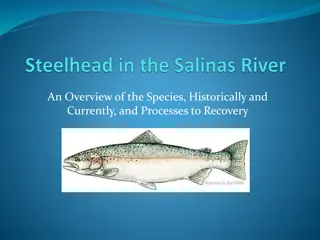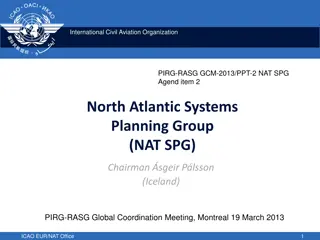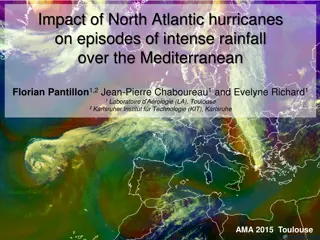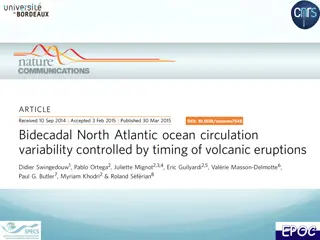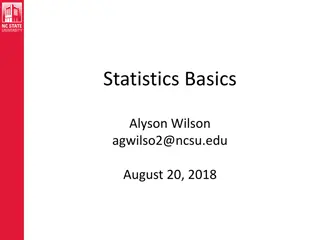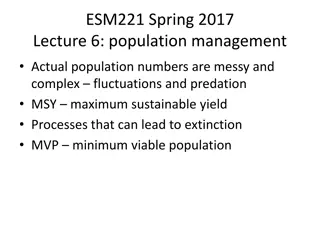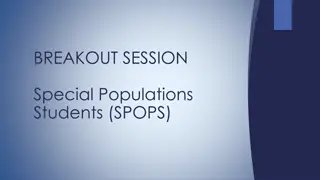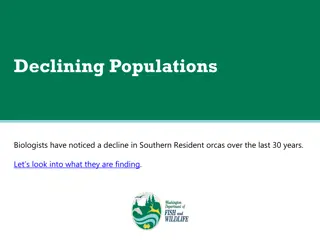Addressing the Decline of Shorebird Populations in the Atlantic Flyway
The presentation focuses on the concerning decline in shorebird populations within the Atlantic Flyway, emphasizing the urgency for increased conservation efforts. It highlights specific species affected by the decline and proposes a comprehensive business strategy involving multiple partners to reverse the trend. The strategy includes measurable goals for population restoration and identifies major threat categories contributing to the decline. The presentation stresses the timely opportunity for collaborative action to protect shorebird populations.
- Shorebird Conservation
- Atlantic Flyway
- Population Decline
- Conservation Strategy
- Environmental Protection
Download Presentation

Please find below an Image/Link to download the presentation.
The content on the website is provided AS IS for your information and personal use only. It may not be sold, licensed, or shared on other websites without obtaining consent from the author. Download presentation by click this link. If you encounter any issues during the download, it is possible that the publisher has removed the file from their server.
E N D
Presentation Transcript
+ Scott Johnston USFWS Division of Migratory Birds scott_johnston@fws.gov
+ A Case For Prioritizing Shorebird Conservation Shorebirds are in jeopardy within the Atlantic Flyway: Warrant increased conservation attention Atlantic Flyway Shorebird Business Strategy can reverse declines: Multiple partners have a timely opportunity to play a role
+ Shorebird Populations are Declining Red Knot Semipalmated Sandpiper 81% 79% Since 2000 Since 1982 G. Breese Winter counts -- Sources: R.I.G. Morrison; L. Niles L. Master Winter counts -- Source: Morrison et al. 2012
+Shorebird Population Declines In the Atlantic Declines reported for 71% of shorebird species Source: Morrison et al. 2006, Andres 2009 Sanderling Marbled Godwit Solitary Sandpiper Red-necked Phalarope Purple Sandpiper Dunlin Lesser Yellowlegs Least Sandpiper Buff-breasted Sandpiper Red Phalarope American Golden Plover Snowy Plover Semipalmated Sandpiper White-rumped Sandpiper American Woodcock Killdeer Western Sandpiper Long-billed Curlew Wilson s Plover Pectoral Sandpiper Willet Wilson s Snipe Red Knot Upland Sandpiper Hudsonian Godwit Whimbrel
+Atlantic Flyway Shorebird Business Strategy - A Timely Opportunity Goal: focal shorebird pops. 10-15% by 2020 Participation:>60 agencies, NGOs, universities Action-oriented: projects, funding, partners Flyway Scale
+Atlantic Flyway Shorebird Business Strategy - Components Major Threat Categories: Habitat Loss & Change Human Disturbance Predation Hunting Knowledge Gaps 15 Focal Species: American Golden Plover Greater Yellowlegs Marbled Godwit Purple Sandpiper Red-necked Phalarope Sanderling Snowy Plover Wilson s Plover Specific activities/projects American Oystercatcher Lesser Yellowlegs Piping Plover Red Knot Ruddy Turnstone Semipalmated Sandpiper Whimbrel
+Shorebird Business Strategy based on American Oystercatcher Measurable Objectives - $ for increased population growth/reduced mortality Process of full engagement of partners Funding and fundraising key parts of Strategy Cumulative conservation impact - leverage partners & resources
+ Next Steps Help lead/encourage partnerships to meet conservation goals Establish strategic partnerships SCSCB (BC) and WHSG meetings NFWF to fund hunting work in Caribbean Adoption of Business Strategy by NFWF as Keystone Initiative
+ Next Steps Using Miradi to refine project outcomes Govt input on actions e. g. hunting policy, habitat Caribbean Flyway Council Link to tourism/industry bonefish shorebird overlap MBTA 100th anniversary Funding, foundations













